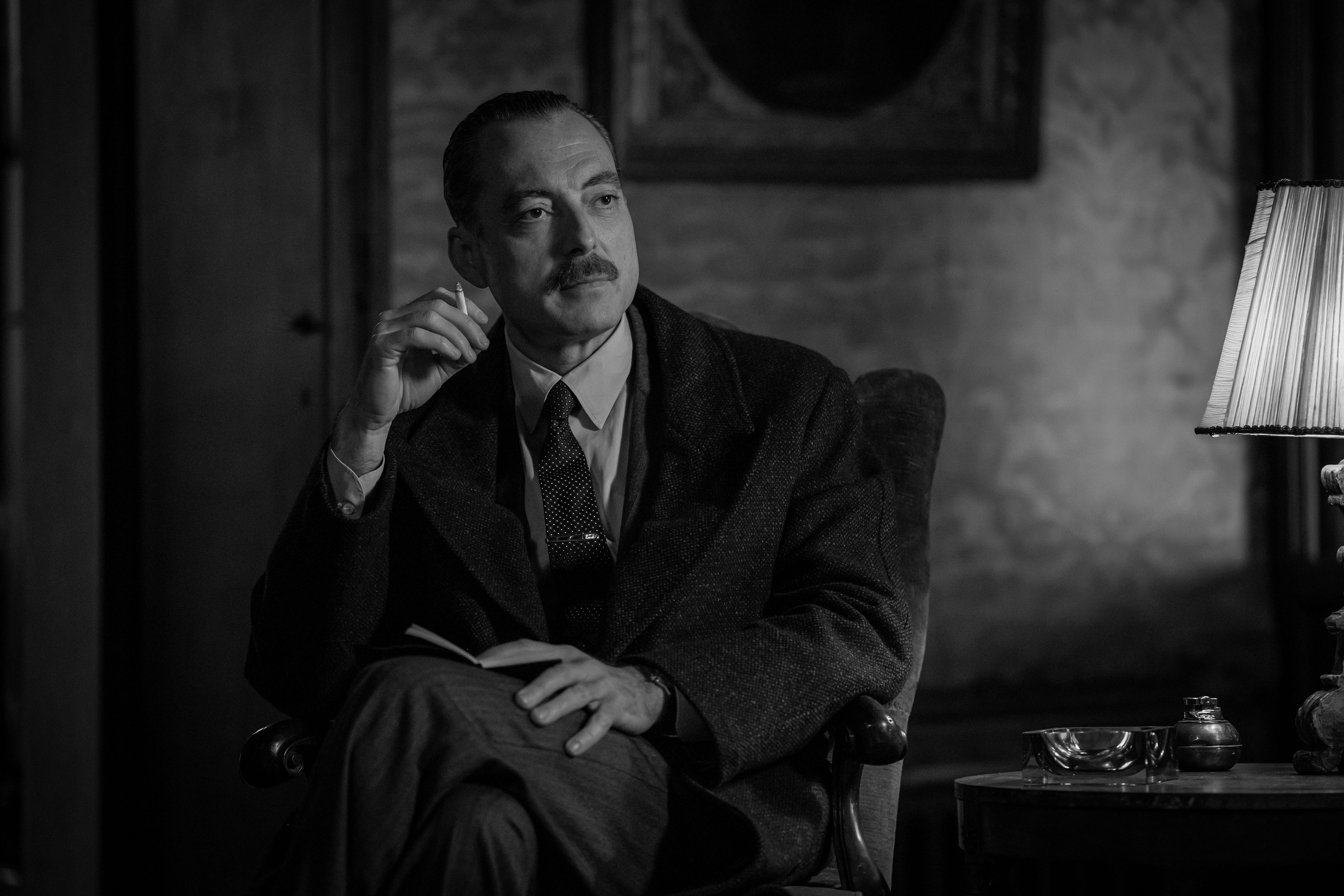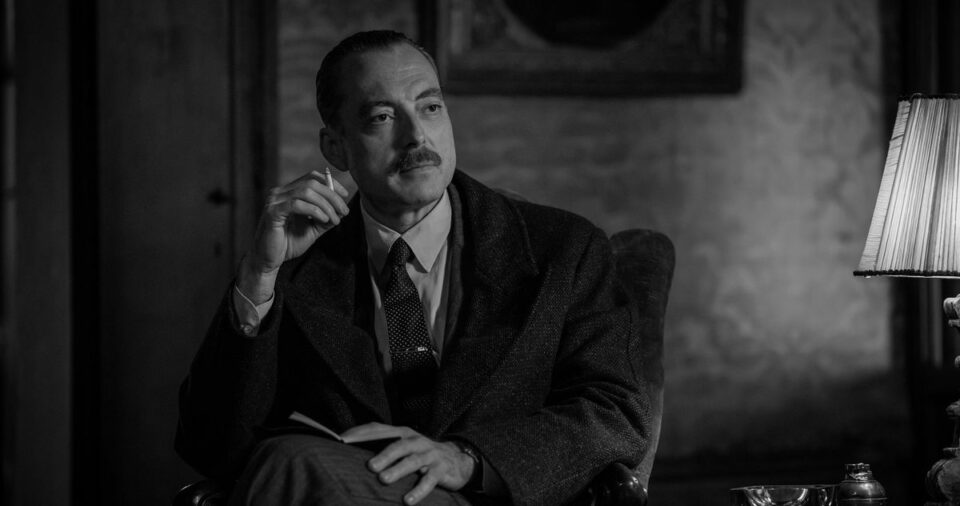
Since first seeing “David with the Head of Goliath” by Caravaggio in Rome, Tom Ripley has been obsessed with the Italian painter. In the season finale, as he works to make his new ginormous, state-of-the-art Venetian palazzo feel like home, he buys a hefty book of pictures by Caravaggio. The writer Michael Prodger, for The New Statesman, defined “Caravaggism” as a sensibility characterized by “dramatic chiaroscuro, unidealized models, earthy realism, sparse settings, concentrated storytelling and striking gesture.” Tom is completely Caravaggian: he has a dramatic flair, loves objects, and has an aggrandized view of himself and his life; his story, which is convoluted and rife with tangled motivations, only gets more concentrated the deeper he wanders into the woods. Caravaggio often painted himself as a bystander on his scenes of religious struggle— as a painter, he was the observer, but as a subject he was a complicit participant. Maybe Tom would think of his impersonation of Dickie along similar lines: he’s both the artist and the subject.
But it’s not just aesthetic affinity that connects Tom to Caravaggio, as Zaillian suggests in “Narcissus.” Caravaggio was, like Tom, a murderer on the run from the authorities. By the time he killed a man called Ranuccio Tomassoni in 1606, allegedly because of a woman, he’d already been convicted of a series of petty crimes: he defamed fellow painters and once assaulted a waiter for bringing him artichokes that’d been cooked in butter rather than olive oil. His crimes, it seems, were often inspired by the need to enact revenge upon his personal, romantic, or professional honor. Fleeing from conviction, Caravaggio anticipated Tom Ripley’s itineraries: he committed crimes in Rome and hid out in Naples and Sicily. As one Caravaggio expert mentions in this (extremely goofy but ultimately informative) BBC documentary about the life of the painter, Caravaggio was a reactive man, easily offended and hellbent on having his perspective of himself triumph over others’ perspectives of him. Sound familiar?
“Narcissus” opens with Caravaggio’s murder of Tomassoni and his subsequent escape to what looks to be a safehouse, where an unidentified but clearly tired woman wonders, out loud, what he’s gotten up to this time. Tom is starting to think more deeply about that chiaroscuro in Venice, where he has just signed a six-month lease on his phenomenal house under his own name. He’s grown a stubble beard and has taken to wearing a hat obstructing one upper quarter of his face, Orson Welles style. In the meantime, back in Rome, Inspector Ravini demands to know where the hell Dickie Greenleaf is. His colleague (who is at the absolute end of his wits with these Americans) in Palermo finds out through the desk clerk in Tom’s last hotel that he’d asked about ferry times to Tunis. After going back and forth on the difference between being depressed and “lost in thought,” the desk clerk communicates that Dickie, wherever he is, didn’t seem well. Inspector Ravini is livid — he puts out a notice in the newspaper that Dickie Greenleaf is suspected of the murders of Freddie Miles and Tom Ripley.
Tom waits until the notice is out in a major newspaper before he can present himself to the Venetian police, feigning disbelief at his supposed disappearance. It’s impossible to speak of what happens next without addressing the bonkers disguise that Tom Ripley — master of impersonation, excellent improviser, and evil genius — apparently comes up with in preparation to speak with Inspector Ravini. He looks like a cross between a lion and a Manson family member. Seeking to reinforce the efficiency of his disturbing look, he remembers a priest’s remark about Caravaggio’s use of light and dark and gaffes his sitting room to look like a scene out of a Henry James ghost story. The Inspector (who doesn’t put two and two together) asks Tom about Dickie’s “affairs of the heart” since his investigation leads him to believe that Freddie and Dickie might have been romantically involved. As the Inspector lays out the facts — Dickie was the last to see Freddie, has refused to present himself for questioning, and has neglected to tell anyone where he is — we can almost see a smile forming under Tom’s Teen Wolf beard. He’d been working to advance an impression of Freddie as a sexual deviant, and to pair Dickie with him would only make his revenge all the more satisfying. One of the tenets of improvisational theater is that you have to take in your scene partner’s suggestions by listening closely to them: you can only yes and if you’ve been keeping track of the story. Tom’s calculation of Dickie’s disappearance was meticulous, but the narrative of Dickie as a depressed gay man has emerged with the help of his adversaries. The thing that Dickie accused Tom of — psychotic jealousy — has become the motivation for Dickie’s own crime.
Apropos of love, my Marge-hating sentiments have been wavering for a few episodes, and even though she has never been more hateful than in the finale, I have to take a moment to self-reflect and become a better person by questioning the root of my hatred. It wasn’t easy to be a woman in the mid-century, least of all a woman committed to her independence, the kind that goes to Europe to pursue her artistic passion and date some guy instead of settling down and getting married like a good girl from Minnesota was meant to do. I didn’t feel so intensely about Marge in the book because she is much more a victim of Tom’s jealousy than she is an agent in the plot; in Zaillian’s interpretation, she is more of an agent than a victim. Her passive-aggressiveness is undercut with purpose: she is provoking Tom, intent on making him feel so bad about his place in the trio that he’d leave by his own accord. This take on Marge feels fresh; her intentional passive-aggressiveness, while maddening, is also a clue to characterization and personality, and a way to bring her to life.
When we first see her in this episode, she is literally posing for journalists, basking in the light of being a tabloid star, high on the opportunity to make her work known through the photographs she provides for magazines. However, it makes little sense why she wouldn’t give the newspapers a picture where Dickie’s face was visible, given that the whole world was looking for him. When she knocks on Tom’s door in Venice, she seems warmer to him already, as if getting in touch with her own selfishness had made her understand Tom’s own. Tom makes one of those classic mistakes where he asks Marge if she wants to stay there out of politeness, and she enthusiastically agrees. But no matter: she’s come with an important bit of information. Inspector Ravini has become convinced that Dickie has killed himself, a hypothesis that could turn into a solution for Tom, and which he starts to build out by prodding Marge for details. So, even though she — meanly!! — spills red wine all over his precious Caravaggio book and generally acts like a bitch on wheels, Tom takes Marge to a party at Peggy Guggenheim’s, where he’s been invited on account of his newfound fame. “Imagine who might be there,” Marge says absurdly. There, everyone wants to talk about Dickie, which Tom thinks is ugly and Marge, with the help of a few martinis, thinks is fun.
Remember what happened last time Tom felt a widening dissonance between his interpretation of reality and that of the person closest to him? Coming home from the party, after Marge implored him to take a gondola and then fell asleep once the boat was gliding along the canal, Tom realizes he’d left the key to the “front” entrance of his palazzo — the one that lets out on the private dock — at home, and so for a moment they are locked outside. Since Marge won’t be a good sport and jump over the iron gate, Tom goes around by himself. When he opens the door to Marge’s drunken body perilously peeking into the canal, he begins to think impure thoughts. He fantasizes about a story so easy it’d be improbable: drunk, she slipped and fell on the mossy steps. But this is the new Tom — he has restraint. The viewer, this one at least, almost sighs with relief. It would be too much!
The next morning, Tom gets a note from Mr. Greenleaf, who has stopped over in Venice to see him. Mr. Greenleaf is the only authority figure of whom Tom seems actually to be afraid — not nervous, like how the Inspector or the policemen at towns’ borders can make him feel, but actually scared. He even tries to get Marge to go with him, but she knows he wants to see him alone — and there’s no way poor Marge could know that the warmth between them gets rekindled over their mutual distaste for her. Like Inspector Ravini, Mr. Greenleaf hopes that Tom can offer some insight into Dickie’s emotional state last he was seen, which Tom concedes didn’t seem great. In one last stroke of that classic Ripley-ean luck, Marge is looking for needle and thread in Tom’s room when she finds Dickie’s signet ring in a little box. Tom immediately picks up the ashtray — how could he have been so stupid! — but Marge’s cluelessness saves her. If Dickie gave Tom the ring, then he knew what he was going to do. He was planning on killing himself all along.
When they go to see Mr. Greenleaf at the hotel with this new bit of information, the P.I. who had tracked Tom down in Manhattan in the very first episode is there. It’s talking to him that — after fantasizing about being found out — Tom makes the final, winning move on his revenge. Dickie knew he was “supremely untalented and that his father disapproved of him,” and he could never love Marge, at least not in the way she wanted him to, because he loved Tom, a confession he made in the secret intimacy of their trip to San Remo. Tom’s rejection came off meaner than intended, and Dickie was never seen again. Not, at least, until Inspector Ravini opens the first page of Marge’s book, a copy of which she has kindly mailed him. It’s dedicated to Dickie, and a full-sized picture of him graces the bottom of the page. At the sight of it, Inspector Ravini’s eyes bulge, which makes him look like an evil version of Anton Ego trying Remy’s ratatouille.
“Narcissus” closes with Tom’s satisfied review of the actions that landed him in an unbelievably nice house in Venice, looking at a Picasso all his own. In the montage, Zaillian cuts repeatedly to the Caravaggio allusion with which he opened the episode. The comparison suggests that Tom’s psychopathy is historical and plumbs a depth in his sensibility that creates a real sense of connection between the character and the art he admires. It’s a case for his love of Caravaggio — he feels they’re kindred spirits — as well as an implication that Zaillian sees Tom as a major artist. But I’m not convinced by the inclusion of the reimagining at the beginning of the episode; not, at least, against the rest of the finale, which dots the i’s in the story deftly. Nothing much is added by that scene, which feels heavy-handed, given that we already know Caravaggio was a fugitive from the museum guide’s explanation all the way back in episode four, when Tom sees “David with the Head of Goliath” for the first time.
Still, ending with the Inspector’s realization, upon finally seeing a picture of Dickie on the first page of Marge’s book, that Tom had pulled a fast one on him is clever; it left me dying to know what Tom would do if the Inspector came back looking for him. The copy I own of the novel smartly offers the reader the first chapter of the next book after the ending of the first. I found myself wishing Netflix would’ve given us a similar taste. That feeling, of course, is the telltale sign that a thriller resonated, and that you can count on the viewer — this one, at least — to come back for more. Is there a more final form of revenge than death? It’s only when he verbalizes his reshaped version of the story that Tom Ripley’s work of art is complete. It’s a tale of reversal: having been the indifferent beloved in life, in death, Dickie Greenleaf is the tortured lover. Tom makes out with the signet ring, an apology from Mr. Greenleaf, and the Picasso that used to hang on the walls of Dickie’s Atrani house. Somehow, being himself, he has gotten farther along than he ever thought he could. In the book, Tom hated having to go back to being Tom Ripley after being Dickie Greenleaf. But it’s only when he owns being Tom Ripley that things fall into place. He’s a genius, a lunatic, a murderer, a freak, and one of the best characters to come out of American literature. And also, Zaillian suggests as the episode closes with a final blending of Ripley and Caravaggio, a major artist of his time.
Postscript
• How good was that John Malkovich cameo? At the first party Tom attends in Venice without Marge, he appears as Reeves, the fake art dealer with whom Tom Ripley partners in Ripley’s Game, the film adaptation of the third book in Highsmith’s series, starring Malkovich as Tom Ripley. Zaillian seems to be gunning for another season here, as Tom has Reeves make a fake British passport for him under which he claims Dickie’s lost Picasso. In the book, by the time Tom has impossibly gotten away with his grift, he has also managed to forge Dickie’s will, bequeathing all of his possessions to himself. It’s inventive on Zaillian’s part to use the Picasso to keep the essential truth of that move while also opening the door to another season.
• All while watching this show, I kept thinking about how Tom Ripley belongs in the ranks of great characters, like James Bond and Hamlet, who only get more compelling the more they’re reinterpreted by talented actors with unique sensibilities. Ripley’s mixture of psychosis and pathos is endlessly remixable, and I loved Andrew Scott’s Tom, who was funny, self-conscious, and serious while also being genuinely touching.
• In Ripley, Kenneth Lonergan plays Mr. Greenleaf. He is married to the great J. Smith Cameron, a.k.a. Gerri from Succession. This made me think of Kendall Roy and Tom Ripley in a room together and what sorts of little schemes they might come up with.
By Rafaela Bassili , 2024-04-06 02:00:54
Source link


